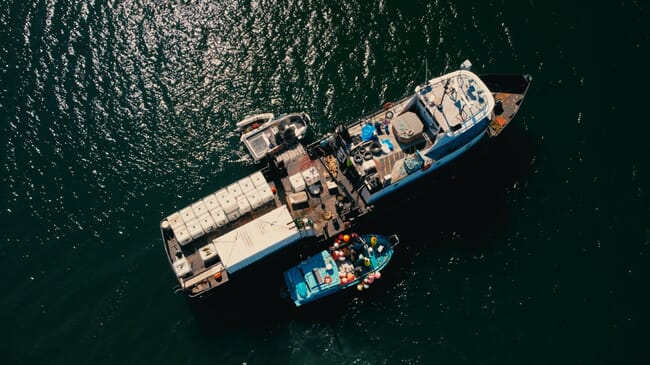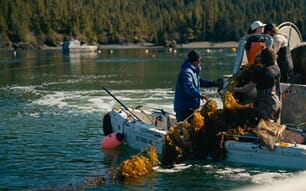
“Today, we harvested all the kelp on the farm. We had six lines of sugar kelp and ten lines of ribbon kelp. The sugar looked good – we’re pretty happy with it. The ribbon kelp? Not so much. Pretty sparse,” Thomas explained on a tour of her site, in May.
This harvest is the result of months of work, starting back in September when Thomas collected wild sori – the reproductive tissue of kelp – to produce seed. The seed was later applied to grow lines at the farm, submerged in the nutrient-rich waters of Windy Bay.
This year’s harvest was made easier by the presence of a Mothers of Millions’ processing vessel, which was aggregating kelp from various farms in the area to deliver to Cascadia seaweed in Canada. The Mothers arrived at the farm the night before, allowing Thomas to harvest directly onto their vessel, without the need for transporting multiple loads to the nearest town, Cordova.
After some startup problems, the team developed a workable system.
“The idea was to pull the 400-foot grow lines over the stern of their boat and cut the kelp off. But the kelp is fragile – it kept breaking,” Thomas says.
As a result they returned to a more familiar method, using Thomas’s own boat and a gill net reel to haul up the lines and hand-cut the kelp, which Cascadia plans to convert into a biostimulant.
“It’s way better than traditional fertiliser,” Thomas notes. “It doesn’t cause runoff like phosphates or nitrates. Farmers love it. It’s not the highest value market, but it’s a good one for now.”
Thomas isn’t new to the water. A commercial salmon fisherman for nearly 40 years, she first encountered kelp in the 1980s and ‘90s, while taking part in the herring roe-on-kelp fishery. That experience gave her a foundation in working with seaweed, but starting a kelp farm presented new challenges.
“It took about a year and a half to get all the permits,” she recalls. “A lease, Fish and Game, the Corps of Engineers – it’s a long process. And then, with my partner Cale, we just started building the structure of the farm. There was no one to teach us. We made a lot of mistakes.”
Now in their fourth season, Royal Ocean has reached a milestone – selling their entire crop for the very first time.
“In the past, we’ve only sold a small amount,” she says. “So we’re excited. Cascadia’s interest has made a huge difference.”
Site selection and farm design
Thomas took the advice of a friend when it came to selecting a site for her farm, and is very happy with the results.
“It’s a nutrient-rich bay, thanks to two salmon streams in the back. And there’s no glacial runoff like on the mainland, so the water’s clean and clear.”
However, she was less fortunate with her initial choice of equipment – as there were no other kelp farms in the area at the time, she followed a design popular in New England, where the seaweed sector was more mature.
If proved unsuitable for Alaska’s harsh conditions, leaving her with tangled lines and a feeble kelp crop. However, a conversation with kelp farmers in Kodiak, where conditions are similar to Prince William Sound, led to a change in fortunes.
“They said, ‘No, you need a catenary design — it keeps tension on the grow lines,’” she explains. “Without tension, they tangle and strip the kelp.”
Cale researched how to construct the arc needed, and it worked.
They also learned about buoy placement the hard way.
“At first, we had one buoy every 200 feet, and our lines drooped so low they scraped the bottom,” she recalls. “Now we use a buoy every 50 feet to keep the kelp within five feet of the surface. It makes a huge difference.”

Scope for growth
Looking ahead, Thomas plans to double their number of grow lines, bringing them closer together. They also hope to adjust their species composition.
“We love ribbon kelp for food, but it didn’t grow well this year,” she admits. “We’ll grow more sugar kelp next season.”
They’re also aiming to move upstream in the value chain. “We don’t want to just keep selling into this low-value fertiliser market,” she says. “We’d much rather sell 10,000 pounds at $1 a pound than 40,000 pounds at 25 cents.”
As a result, they are looking to break into the food or cosmetics markets.
“That’s where the value is. But to do that, we need dried product,” Thomas explains.
A drying unit expected this year never arrived, unfortunately. But Thomas is more optimistic about next year’s potential.
“Hopefully next year, we can dry and mill the kelp and get it into products.”
To reach these more lucrative markets Thomas says that farmers will also need help.
“We need a liaison – someone who knows the food companies, cosmetics R&D teams, how to contact them,” she says. “We’re fishermen and farmers, not marketers.”
She’d love for the Alaska Seafood Marketing Institute (ASMI) to help market the state’s kelp, but current legislation doesn’t allow it. Meanwhile, Cale has been experimenting with smoked kelp in his smokehouse, selling it in small packets.
“I’ve taken it and turned it into furikake with sesame seeds and spices,” Thomas notes. “People love it. We’d love to sell direct-to-consumer, like Barnacle Foods does.”

Building local capacity
Another obstacle to overcome relates to sourcing seed – with no local supply, Royal Ocean currently sources it from Seward, which involves complex logistics.
“Boats, planes, trucks – it’s a hassle,” Thomas says. “We’re hoping for a hatchery in Cordova next season. That would simplify everything.”
Labour is another challenge.
“We can’t do it all ourselves, and since it only happens a couple times a year, it’s hard to keep a trained crew. But people are interested and often come back,” she notes.
Despite the range of difficulties, Thomas remains optimistic.
“We were so happy at the dock after harvest, but we immediately started talking about next year,” she reflects. “That says a lot – we’re still excited.”
*This article is part of a project commissioned by the SEC to highlight the region's mariculture sector. To learn more about the sector visit https://alaska.seaweedinsights...








